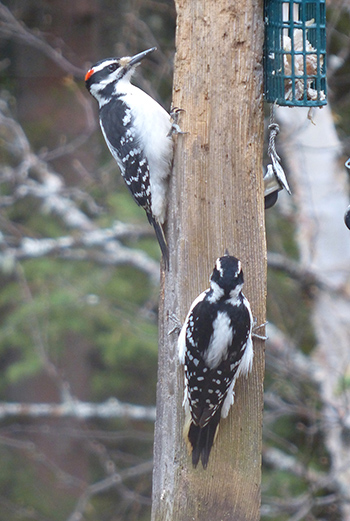Unveiling the Tricks of Woodpeckers: Actions, Habitat, and A Lot More
Woodpeckers, with their special habits and specialized adaptations, have lengthy fascinated researchers and nature fanatics alike. By revealing the enigmas bordering woodpeckers' habits and habitat choices, a much deeper understanding of these bird wonders emerges, offering a glimpse right into their interesting world.
Woodpecker Behavior Insights
In examining woodpecker habits, a fascinating display screen of specialized skills and adjustments emerges, dropping light on their remarkable environmental niche. Woodpeckers, understood for their distinctive drumming on trees, possess a selection of behavioral traits that contribute to their survival and success in their environment.
Moreover, woodpeckers show a special feeding actions characterized by their capability to extract bugs from tree bark utilizing their specialized beaks. Their lengthy, barbed tongues aid in catching prey, while their strong neck muscular tissues offer security and accuracy during pecking movements. This feeding approach allows woodpeckers to gain access to concealed insect larvae and remove them with amazing effectiveness.
Environment Preferences and Selection
What aspects affect the environment preferences and choice of woodpeckers? Woodpeckers are extremely versatile birds known to occupy different settings worldwide. They do exhibit preferences for specific environment features. One crucial element affecting woodpecker environment choice is the schedule of ideal nesting websites. Woodpeckers generally favor woodlands with a mix of mature trees that provide sufficient chances for tooth cavity excavation. These tooth cavities act as critical nesting and roosting websites for woodpeckers and are crucial for their reproducing success.
Furthermore, woodpeckers show a preference for environments with a bountiful supply of food resources. They are mainly insectivorous, feeding upon beetles, ants, larvae, and other pests discovered in rotting wood or tree bark. Woodpeckers have a tendency to favor woody areas with a diverse insect populace to fulfill their dietary needs.
In addition, the existence of dead or decaying trees is an additional essential element in woodpecker environment choice. These trees not just supply food sources yet likewise supply appropriate substrate for cavity excavation. Dead trees are essential for the upkeep of healthy woodpecker populaces, as they play an important duty in the woodpeckers' life cycle and ecosystem characteristics.
Feeding Habits and Diet Make-up
Woodpeckers demonstrate a specialized feeding habits concentrated on foraging for insects within various environments. In enhancement to pests, woodpeckers also take in tree sap, fruits, nuts, and seeds, adding range to their diet regimen depending on the period and availability of food sources.
The foraging strategies of woodpeckers are well-adapted to their arboreal way of living (Woodpeckers in Florida). Their capacity to dig deep into timber not just gives them with food yet additionally helps in creating nesting cavities and establishing territories. Woodpeckers play an important function in maintaining the health of forests by regulating insect populaces and assisting in the disintegration of wood. Comprehending their feeding practices and diet regimen structure is essential for conservation initiatives targeted at protecting these distinct and important birds.
Drumming Sounds and Interaction
Using rapid drumming audios on different surfaces, woodpeckers use an unique form of interaction to indicate area borders and draw in mates. This drumming actions is not only a means of interaction but additionally serves as a means for woodpeckers to develop their presence within a certain area. The intensity, speed, and pattern of the drumming can convey crucial info to other woodpeckers in the location.
Woodpeckers utilize drumming noises to announce their visibility in a region and to visit this site right here alert off possible trespassers. The loud and repetitive nature of the drumming works as a clear signal to other woodpeckers that the location is already asserted. This assists in lowering disputes and decreasing physical conflicts in between individuals.

Survival Adaptations and Specialized Composition

Verdict
Finally, woodpeckers display distinct behaviors, such as pop over to these guys drumming audios for interaction, and have specialized makeup for survival in their selected habitats. Their feeding behaviors and diet regimen structure further show their versatility to various settings. By comprehending these aspects of woodpeckers, scientists and guardians can better shield and preserve these remarkable birds and their environments.